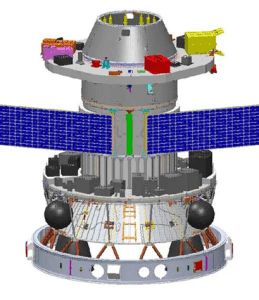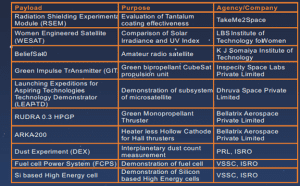TAG: GS 3: SCIENCE AND TECHNOLOGY
THE CONTEXT: The Indian Space Research Organisation (ISRO) has achieved a remarkable milestone in space exploration by successfully conducting the PSLV-C58/XPoSat mission, leaving virtually no debris in Earth’s orbit. This achievement is significant amidst the growing concern over space debris resulting from increased satellite launches.
EXPLANATION:
- ISRO’s innovative approach involved transforming the fourth stage of the Polar Satellite Launch Vehicle (PSLV) into a unique orbital station named the PSLV Orbital Experimental Module-3 (POEM-3).
- Instead of leaving the fourth stage to float in orbit after completing its mission, ISRO repurposed it into POEM-3, which served as an experimental platform.
POEM:
- It has been developed by the Vikram Sarabhai Space Centre (VSSC) as an inexpensive space platform, POEM uses the spent fourth stage of a PSLV rocket as an orbital platform.
- It was used for the first time in the PSLV-C53 mission in June 2022, ISRO had POEM orbit the earth as a stabilised platform to perform in-orbit scientific experiments with various payloads.

Image of PSLV Orbital Experimental Module (POEM)
- POEM is powered by solar panels mounted on the fuel tank of the rocket’s fourth stage and a lithium-ion (Li-ion) battery.
- It has a dedicated navigation, guidance, and control (NGC) system to stabilise its altitude along with helium control thrusters.
- The NGC system has four Sun sensors, a magnetometer, and gyroscopes, and talks to ISRO’s NavIC satellite constellation for navigation.
- POEM also has a telecommand system to communicate with the ground station.
- ISRO first demonstrated the reuse of the spent fourth stage of its rocket in its PSLV C-44 mission in 2019.
- After satellites were injected in the target orbits, the fourth stage, carrying a student payload called Kalamsat-V2, was moved to a higher circular orbit of 443 km and stayed there, allowing the payload to make observations.
POEM-3’s Achievements:
- During the PSLV C-58 mission, POEM-3 hosted nine payloads from various organizations, including VSSC, Bellatrix Aerospace Pvt Ltd, and several start-ups.
- POEM-3 featured nine payloads: two each from VSSC and Bellatrix Aerospace Pvt Ltd, one each from the start-ups TakeMe2Space, Inspecity Space Labs Pvt Ltd., Dhruva Space, and from LBS Institute of Technology, KJ Somaiya Institute of Technology, and ISRO’s Physics Research Laboratory, Ahmedabad.
- These payloads conducted a range of experiments while orbiting Earth, demonstrating the versatility and effectiveness of the platform.

Preparation for Re-entry:
- After completing its experimental phase, POEM-3 underwent careful preparations for re-entry into Earth’s atmosphere.
- ISRO tracked the module using its Telemetry, Tracking and Command Network (ISTRAC) stations, ensuring a controlled descent to minimize any potential risks associated with debris.
Significance in Dealing with Space Debris Crisis:
- The achievement of zero orbital debris by ISRO holds immense significance in addressing the global challenge of space debris.
- With an increasing number of satellites in orbit, the risk of collisions and the proliferation of debris poses a threat to space assets and future space missions.
- In 2022, four on-orbit break-up events occurred, contributing to most of the debris created that year:
- March 2022: Intentional destruction of Russia’s Cosmos 1048 in an anti-satellite test adding 1408 fragments of debris
- July 2022: Break-up of the upper stage of Japanese H-2A while deploying GOSAT-2 satellite adding 52 fragments of debris
- November 2022: Accidental explosion of the upper stage of China’s Yunhai-3 adding 533 pieces of debris
- November 2022: Break up of the Japanese H-2A upper stage for the deployment of GCOM satellite adding 30 pieces of debris
- The rise in space debris has been exacerbated by events such as intentional destruction during anti-satellite tests and accidental break-ups of rocket stages.
- These incidents contribute to the growing volume of debris in both low Earth orbit (LEO) and geosynchronous orbit (GEO), posing risks to operational satellites and spacecraft.
- Space agencies worldwide are actively working on strategies to mitigate space debris.
- Initiatives include adopting guidelines for space debris mitigation, developing technologies for debris removal, and conducting research on orbital tracking and collision avoidance.
- Countries like China, Japan, and the United States have launched initiatives to address space debris.
- These efforts range from deploying spacecraft for de-orbiting defunct satellites to developing advanced technologies for debris capture and removal.
ISRO’s Contribution to Space Debris Mitigation:
- Apart from the POEM missions, ISRO has established a Space Situational Awareness Control Centre and is actively involved in research and development efforts to mitigate space debris.
- Indian start-ups, such as Manastu Space, are also contributing to the development of technologies for satellite servicing and debris removal.

